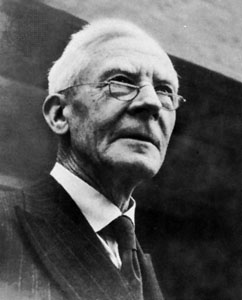| Edgar Adrian  AKA Edgar Douglas Adrian AKA Edgar Douglas Adrian
Born: 30-Nov-1889
Birthplace: London, England
Died: 4-Aug-1977
Location of death: London, England
Cause of death: unspecified
Remains: Buried, Trinity Chapel College, Cambridge University, England
Gender: Male
Race or Ethnicity: White
Sexual orientation: Straight
Occupation: Scientist, Doctor Nationality: England
Executive summary: Electricity within nerve cells Lord Edgar Adrian studied muscles and nerve cells, first performing crude measurements of nerve impulses by using valve amplifiers, and later devising more accurate instrumentation for such assessments. He accidentally proved the presence of electricity within nerve cells, after attaching electrodes to a toad's optic nerves and then noting increased impulse activity every time he happened to step across the animal's field of vision. He measured the brain impulses of goldfish and water beetles, and showed how Hans Berger's alpha rhythms (the recurring disturbances caused when electrodes were applied to the head of a conscious subject) were applicable to epilepsy. He was the first to isolate reactions from a single nerve fiber, investigated the motor cortex, cerebellum, nerve gases, and vestibular receptors.
Adrian was awarded the Nobel Prize in medicine in 1932, shared with Sir Charles Sherrington. Among numerous other honors, he was granted peerage as a baron by Queen Elizabeth II, served as a member of the House of Lords, was a trustee for the Rockefeller Institute for Medical Research, and a board member at the World Health Organization.
His wife, Hester Agnes Pinsent, was a direct descendant of philosopher David Hume. Their son Richard married geographer Lucy Caroe, granddaughter of Sir William Bragg, and their daughter Anne married physiologist Richard Keynes, nephew of economist John Maynard Keynes and great-grandson of Charles Darwin. David Hume Pinsent, the brother of Adrian's wife, was a close friend of Ludwig Wittgenstein, who dedicated his Tractatus Logico-Philosophicus to him, and Pinsent's diaries were published as A Portrait of Wittgenstein as a Young Man. Father: Alfred Douglas Adrian (attorney, b. 1845, d. 1922)
Mother: Flora Lavinia Barton Adrian (b. 1858, m. 1885, d. 1935)
Brother: Harold Adrian (b. 1886, d. 1886)
Wife: Hester Agnes Pinsent (mental health worker, b. 1899, m. 14-Jun-1923, d. 1966)
Daughter: Anne Pinsent Adrian Keynes
Son: Richard Hume Adrian (physiologist, b. 1927 twin, b. 1995)
Daughter: Jennet Adrian Campbell (b. 1927 twin)
High School: Westminster School, London, England (1908)
University: BA Natural Science, Cambridge University (1911)
Medical School: MD, Cambridge University (1915)
Teacher: Neurology, Cambridge University (1919-29)
Professor: Foulerton Professor of the Royal Society (1929-37)
Professor: Physiology, Cambridge University (1937-51)
Administrator: Cambridge University (1951-75)
Royal Society President (1950-55)
Royal Society Foreign Secretary (1946-50)
Royal Society 1923
Royal College of Physicians 1924
Nobel Prize for Medicine 1932 (with Sir Charles Sherrington)
Royal Medal 1934
Order of Merit 1942
Copley Medal 1946
Life Peerage 1955 as Baron Adrian of Cambridge
World Health Organization 1962
Author of books:
The Basis of Sensation (1928, research)
The Mechanism of Nervous Action (1932, research)
Factors Determining Human Behavior (1937, research)
The Conduction of the nervous impulse (1917, research, with Keith Lucas)
The Physical Background of Perception (1947, lectures)
Requires Flash 7+ and Javascript.
Do you know something we don't?
Submit a correction or make a comment about this profile
Copyright ©2019 Soylent Communications
|